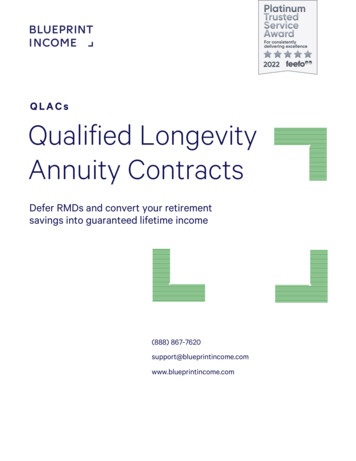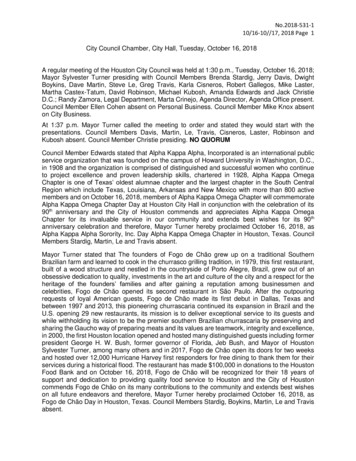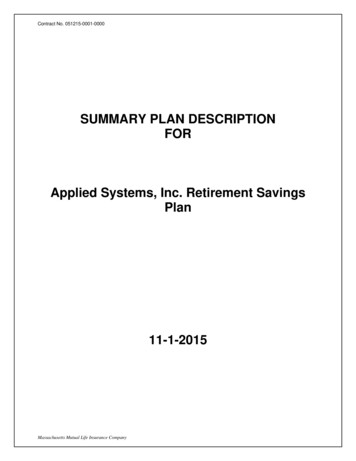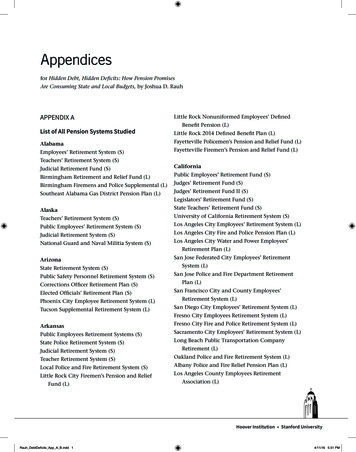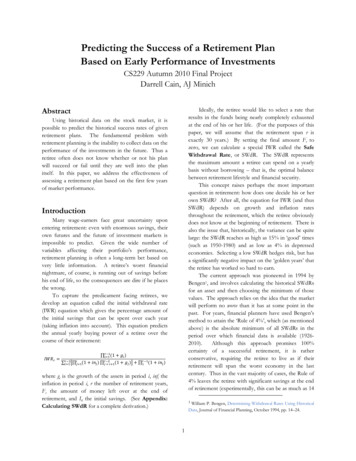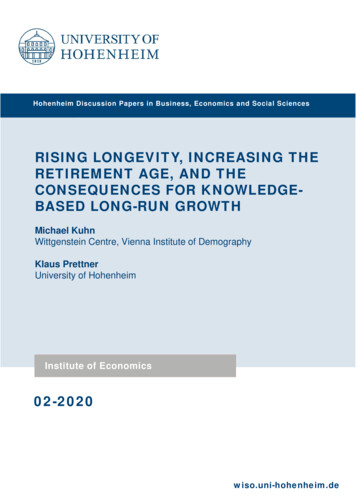
Transcription
HohenheimDiscussionin Business, Economics and Social SciencesFakultät/ Zentrum/Projekt PapersXYInstitut/ Fachgebiet YZRISING LONGEVITY, INCREASING THERETIREMENT AGE, AND THECONSEQUENCES FOR KNOWLEDGEBASED LONG-RUN GROWTHMichael KuhnWittgenstein Centre, Vienna Institute of DemographyKlaus PrettnerUniversity of HohenheimInstitute of Economics02-2020wiso.uni-hohenheim.de
Discussion Paper 02-2020Rising longevity, increasing the retirement age, and theconsequences for knowledge-based long-run growthMichael Kuhn, Klaus PrettnerDownload this Discussion Paper from our homepage:https://wiso.uni-hohenheim.de/papersISSN 2364-2084Die Hohenheim Discussion Papers in Business, Economics and Social Sciences dienen derschnellen Verbreitung von Forschungsarbeiten der Fakultät Wirtschafts- und Sozialwissenschaften.Die Beiträge liegen in alleiniger Verantwortung der Autoren und stellen nicht notwendigerweise dieMeinung der Fakultät Wirtschafts- und Sozialwissenschaften dar.Hohenheim Discussion Papers in Business, Economics and Social Sciences are intended to makeresults of the Faculty of Business, Economics and Social Sciences research available to the public inorder to encourage scientific discussion and suggestions for revisions. The authors are solelyresponsible for the contents which do not necessarily represent the opinion of the Faculty of Business,Economics and Social Sciences.
Rising longevity, increasing the retirement age, and theconsequences for knowledge-based long-run growth Michael Kuhn and Klaus Prettnera) Wittgenstein Centre (Univ. Vienna, IIASA, VID/ÖAW),Vienna Institute of DemographyWelthandelsplatz 2, Level 2A-1020, Vienna, Austriaemail: michael.kuhn@oeaw.ac.atb) University of HohenheimInstitute of EconomicsSchloss, Osthof-West,70593 Stuttgart, Germanyemail: klaus.prettner@uni-hohenheim.deCorresponding authorAbstractWe assess the long-run growth effects of rising longevity and increasing theretirement age when growth is driven by purposeful research and development.In contrast to economies in which growth depends on learning-by-doing spillovers,raising the retirement age fosters economic growth. How economic growth changesin response to rising life expectancy depends on the retirement response. Employing numerical analysis we find that the requirement for experiencing a growthstimulus from rising longevity is fulfilled for the United States, nearly met for theaverage OECD economy, but missed by the EU and by Japan.JEL classification: J10, J26, O30, O41.Keywords: Demographic Change, Rising Life Expectancy, Pension Reforms,Long-Run Economic Growth, R&D, Innovation. An earlier version of this paper circulated with the title “On the long-run growth effect of raisingthe retirement age”.1
1IntroductionRich countries have been facing unprecedented increases in life expectancy over the pastdecades. For example, life expectancy in the United States increased from about 69years in the 1950s to about 79 years in 2020, while it increased by even more in countriessuch as France and Germany, from about 67 years in the 1950s to more than 80years in 2020 (United Nations, 2019). This development undoubtedly raises individualwell-being (Kuhn and Prettner, 2016; Baldanzi et al., 2019). However, it also comeswith certain economic concerns. If people live longer for a constant retirement age,the resulting increase in economic dependency could lead to a reduction in economicgrowth and pose a threat to the sustainability of social security systems and pensionfunds (Gruber and Wise, 1998; World Economic Forum, 2004; The Economist, 2009,2011; Bloom et al., 2010). The extent to which this is true, however, also depends onthe extent to which individuals change their savings behavior in response to increasinglongevity and on the extent to which retirement policies are adjusted to cope withdemographic change (Bloom et al., 2007, 2010).The economic effects of changing life expectancy and changing retirement policieshave been analyzed, for example, by Futagami and Nakajima (2001), Heijdra andRomp (2009), Bloom et al. (2007, 2014), Heijdra and Mierau (2011), and Prettner andCanning (2014). These papers either assume a partial equilibrium perspective in whichthe interest rate and economic growth do not react to individual decisions, or they arebased on models in which growth is driven by physical capital accumulation either withdecreasing returns to capital accumulation a la Solow (1956), Cass (1965), Koopmans(1965), and Diamond (1965) or with constant returns to capital accumulation dueto learning-by-doing spillovers a la Romer (1986) and Rebelo (1991). However, longrun economic growth in rich countries is mainly driven by purposeful research anddevelopment (R&D) investments (Romer, 1990; Aghion and Howitt, 1992; Jones, 1995;Kortum, 1997). To analyze the effects of rising life expectancy and changing theretirement age for these economies, we therefore integrate a demographic structure ofoverlapping generations in the vein of Blanchard (1985) into the endogenous R&Dbased growth model of Romer (1990) with a given retirement age.In a first step, we show that increasing the retirement age raises economic growthand the equilibrium interest rate because the positive growth effect of the larger workforce implied by a longer working life overcompensates for the negative growth effect ofreduced savings. Thus, raising the retirement age might be an accurate policy responseto the phenomenon of secular stagnation in which economic growth is sluggish and theequilibrium interest rate is stuck below zero (Eggertsson et al., 2019, 2020).The savings channel – and the savings channel only – also features in Futagamiand Nakajima (2001) and Heijdra and Mierau (2011) who find that an increase in theretirement age leads to a reduction of capital accumulation and therefore to a reduction2
of economic growth in a Romer (1986) model in which growth is driven by capitalaccumulation with learning-by-doing spillovers. While their results are highly relevantfor economies with exogenous technological progress (e.g., mostly small economiesadopting technologies from abroad), our results imply the opposite effect in countriesthat drive the world-wide technological frontier such as Germany, Japan, and theUnited States. The opposing results are also interesting from a theoretical point ofview: It is often argued that results based on endogenous growth models with learningby-doing spillovers (Romer, 1986) are very similar to the results based on R&D-drivengrowth models (Romer, 1990). Our contribution shows that this is not the case whenanalyzing the implications of an increase in the retirement age. Thus, from a policyperspective, it is important to keep the underlying structure of the economy intoaccount when considering retirement policies.In a second step, we show that the extent to which economic growth changes inresponse to rising life expectancy depends on the accompanying pension policies. Thisis because as long as the boost to savings that is brought about by an increase inlongevity is not very strong, the increase in economic dependency that comes withgreater longevity for a given retirement age will typically lead to a reduction in R&Dactivity and economic growth. We show that an increase in the retirement age inproportion to an increase in life expectancy is sufficient for an increase in longevity tostimulate economic growth. We also provide a necessary and sufficient condition for apositive growth impulse, requiring the elasticity of the retirement age with respect tothe increase in longevity to be sufficiently large. Our analysis concludes with a set ofnumerical examples, studying how the United States, the European Union economy,Japan, and the average OECD economy have fared in respect to the rise in longevityover the time span 2000–2017. We find that only the United States have clearlybenefited in terms of higher economic growth, whereas the growth stimulus from thelongevity increase was neutral for the OECD and negative for the European Union andJapan. Our numerical results also suggest that a longevity-driven boost to savings ismuch weaker than the effects that run through changes in labor participation.The paper is organized as follows. In Section 2 we set up an overlapping generationsversion of the R&D-based endogenous growth model of Romer (1990) with a fixedretirement age. In Section 3 we derive our main results and discuss their relevance foractual retirement policies carried out in different countries. Finally, in Section 4 wedraw our conclusions.3
2The model2.1Household sideConsider an economy in which individuals enter the labor market as adults at time t0and maximize their remaining discounted stream of lifetime utility given byZU log(c)e (ρ µ)(t t0 ) dt,(1)t0where c is instantaneous consumption, ρ is the pure rate of time preference, and µrepresents the mortality rate that augments the rate of time preference because therisk of death constitutes a further reason to consume earlier in life rather than later.Individuals earn non-capital income w (wages and lump-sum redistributions of profitsfrom intermediate goods producers) as long as they are not retired. Suppressing timearguments and following Yaari (1965) in assuming that individuals save in terms offair annuities that insure against the risk of dying with positive capital holdings, theflow budget constraint readsk̇ χw (µ r)k c,(2)where k denotes the individual capital stock and χ is an indicator function with value1 when working and 0 when retired (Bloom et al., 2007; Prettner and Canning, 2014).The first term in the flow budget constraint relates to income earned on the labormarket and from receiving the lump-sum redistributions of profits (Kuhn and Prettner,2016). This term becomes zero once an individual retires. The second term refers to theinterest earnings on capital holdings (rk), which are augmented by the redistributionof capital from people who die to those who survive via the annuity market (µk).If individuals have a higher income than their consumption expenditures at a giveninstant, their capital stock accumulates (k̇ 0).Solving the intertemporal maximization problem as represented by Equations (1)and (2) leads to the standard Euler equationċ (r ρ)c(3)stating that consumption expenditure growth depends positively on the difference between the interest rate and the rate of time preference.The lifetime budget constraint isZ e (µ r)(t t0 )tZ0 Re (µ r)(t t0 ) w(t0 , t)dt,c(t0 , t)dt t0t04
where lifetime consumption expenditures (the left-hand side) have to equal lifetimeincome (the right-hand side). In this expression, the working life span is denoted by Rsuch that the age at retirement is given by t0 R in the upper bound of the integralon the right-hand-side that represents lifetime income. For a constant age at labormarket entry t0 , an increase in R is tantamount to an increase in the retirement age.Denoting the aggregate capital stock by K and aggregate consumption expendituresby C, we have the following definitions to derive the corresponding variables (see forexample Blanchard, 1985; Prettner, 2013; Heijdra, 2017, chapter 15):ZtK(t) k(t0 , t)N (t0 , t)dt0 ,(4)c(t0 , t)N (t0 , t)dt0 ,(5) Z tC(t) where N (t0 , t) denotes the size of the cohort entering the labor market at time t0 asof date t, while k(t0 , t) and c(t0 , t) are the capital holdings and consumption levels ofthe members of this cohort at time t, respectively. To capture the case of a stationarypopulation, which is reasonably close to the situation in many rich countries, we assumethat the birth rate equals the death rate. In this case, the flow of labor market entrantsRtis N (t, t) µN (t), where N (t) N (t0 , t)dt0 N represents the adult populationRtsize and L(t) t R N (t0 , t)dt0 is the labor force. Note that, in our setting, i) eachadult cohort is of size µN eµ(t0 t) at a certain date t t0 , ii) the cohort fertilityrate stays constant for a changing mortality rate µ such that the fertility decisions ofindividuals do not change for changing parameters, and iii) a change in the mortalityrate does not change the population size such that the scale effect in the Romer (1990)framework is neutralized with respect to the overall population size.1Taking into account our demographic structure and using the stated aggregationrules leads to the following dynamic equations for the aggregate capital stock and foraggregate consumptionK̇ rK W C,ĊC r ρ µ(ρ µ)(6)K,C(7)where W refers to aggregate non-capital income.The resource constraint states that aggregate production Y is either consumed orinvested in physical capital such that the goods market clearing conditionK̇ Y C1(8)Assuming a growing population as in Buiter (1988) together with a semi-endogenous growthframework as in Jones (1995) would imply similar effects as the ones that we find during the transitionto the long-run balanced growth path.5
is fulfilled. Next we turn to the description of the production side of the economy.Since the production side closely follows the R&D-based endogenous growth literature,we only state the most important equations that we need for the further analysis ofchanging the retirement age and changing life expectancy.2.2Production sideThere are two types of workers in the economy. The first type (LY ) is employed inthe final goods sector to assemble the consumption aggregate. The second type (LA )refers to scientists in the R&D sector who develop the new technologies (“blueprints”for machines or simply “ideas”) that drive productivity growth in knowledge-basedeconomies (see, for example, Romer, 1990; Grossman and Helpman, 1991; Aghionand Howitt, 1992). To produce the consumption aggregate, the representative firmin the final goods sector combines workers and machines according to the productiontechnologyY LY1 αZAxαi di,(9)0where A is the stock of technology in the country, xi is the quantity of a specificmachine i used in final goods production, and α (0, 1) is the elasticity of final outputwith respect to machines. Taking the final good as the numéraire, profit maximizationof final goods producing firms together with the assumption of perfect competitionin the final goods market imply that the wage rate for workers, wY , and the price ofmachines, pi , are given bywY (1 α)Y,LYα 1.pi αL1 αY xi(10)Each intermediate firm produces one of the differentiated machines such that thereis monopolistic competition in the vein of Dixit and Stiglitz (1977). After a firm haspurchased a blueprint from the R&D sector, it has access to a production technologythat allows them to convert one unit of capital k into one machine x such that ki xifor all firms i. Thus, operating profits can be written asπi pi ki rki αLY1 α kiα rki .(11)Profit maximization of firm i yields the optimal pricing policy pi r/α, where 1/α isthe markup over marginal cost (Dixit and Stiglitz, 1977). As a consequence, the aggregate capital stock is equal to the total quantity of intermediates, i.e., K Ax. Usingthis, the aggregate production function [Equation (9)] becomes Y (ALY )1 α K α andproduction per capital unit can be written as a function of the interest rate and theelasticity of final output with respect to machines r αp α2 Y /K Y /K r/α2 .The R&D sector employs scientists to discover new technologies (Romer, 1990).6
Depending on the productivity of scientists, λ, and their employment level, LA , thestock of blueprints evolves according toȦ λALA .(12)R&D firms maximize their profits πA pA λALA wA LA , with pA representing theprice of a blueprint, by choosing the employment level, LA . The first-order condition ofthis profit maximization problem pins down wages in the research sector as wA pA λA.Due to perfect labor mobility, wages of workers in the final goods sector and wages ofscientists equalize at the labor market equilibrium such thatwA pA λA (1 α)Y wY .LY(13)Firms in the R&D sector charge a price for the blueprint they produce that is equalto the present value of operating profits in the intermediate goods sector. The reasonis that there is always a potential entrant who is willing to outbid a lower price.Consequently, ZpA e Ω(τ ) π dτtholds in equilibrium, where Ω(τ ) Rτtr(s) ds denotes the compound interest betweent and τ . Via the Leibniz rule and the fact that prices of blueprints do not changealong a balanced growth path (BGP), we obtain the long-run equilibrium price of ablueprint aspA π.rNext, by using Equation (11), we get operating profits as π (1 α)αY /A such thatthe price of blueprints becomes pA (1 α)αY /(rA). Using the labor market clearingcondition L LA LY , we can then determine the quantity of labor employed in thefinal goods sector and in the R&D sector by using Equation (13) asLY r,αλLA L r.αλ(14)This endogenous division of labor determines the flow of new technologies in the R&Dsector. Inserting Equation (14) into Equation (12) leads to the evolution of technologyas rAȦ max λAL , 0 .α(15)Now we have all the necessary ingredients to solve for the long-run BGP and to assessthe effects of changing life expectancy and a changing retirement age on economicgrowth.7
3The impact of rising longevity and changing retirementpolicies on long-run growthAlong a BGP, we know that the growth rates of technology, capital, and consumptioncoincide such that Ȧ/A Ċ/C K̇/K g. Collecting Equations (7), (8), (15),Rtrecalling that labor supply is given by L(t) t R N (t0 , t) dt0 , and utilizing thedefinition C/K ξ, we derive the following three-dimensional system describing ourmodel economy along the BGPg r ξ,α2(16)1g r ρ µ(ρ µ) ,ξZ trN (t0 , t) dt0 .g λαt R(17)(18)In this system, the endogenous variables are the interest rate (r), the consumption-tocapital ratio (ξ), and the long-run economic growth rate (g). Since this system cannotbe solved explicitly, we turn to implicit comparative statics to prove the analyticalresults in Propositions 1 and 2. We focus on two sets of insights: In a first step, weconsider the balanced-growth impact of an isolated change in the retirement age. Ina second step, we consider the balanced-growth impact of a change in longevity andstudy how this depends on potential adjustments in the retirement age.Proposition 1. In the endogenous growth framework of Romer (1990) with overlapping generations and retirement, an increase in the retirement age (a rise in R) leadsto(i) an increase in the interest rate (r) and(ii) an increase in the long-run economic growth rate (g).Proof. Noting thatRt µR , we rewrite the system (16)-(18)N(t,t)dt N1 e00t RasW (ξ, g, r) : r ξ g 0,α21X (ξ, g, r) : r ρ µ(ρ µ) g 0,ξ rY (ξ, g, r) : λN 1 e µR g 0.α(19)(20)(21)Applying the implicit function theorem and Cramer’s rule, we obtain the following8
comparative staticsdgdR drdR λµN e µR α2 ξ 2 µ(µ ρ) 0,(1 α) [αξ 2 µ(µ ρ)] α2 λµN e µR µ(µ ρ) ξ 2 0.(1 α) [αξ 2 µ(µ ρ)](22)(23)Hence, in contrast to Futagami and Nakajima (2001) and Heijdra and Mierau(2011), who base their analysis on a Romer (1986) framework in which growth isdriven by physical capital accumulation via learning-by-doing spillovers, an increase inthe retirement age unambiguously raises economic growth in a Romer (1990) setting.The intuition for this result is that a rise in the retirement age implies an increase inthe labor force and therefore it raises the number of scientists that are available forthe production of blueprints in the R&D sector. While there is also a reduction inindividual savings due to the longer working life (as in Futagami and Nakajima, 2001;Heijdra and Mierau, 2011), the associated negative growth effect is overcompensatedby the positive effect of the larger labor force.The difference in the results suggests that in economies in which growth is mainlydriven by purposeful R&D investments (such as Germany, Japan, and the UnitedStates), an increase in the retirement age will indeed lead to a rise in the long-runeconomic growth rate. However, in economies, in which growth is mainly driven byphysical capital accumulation coupled with learning-by-doing spillovers (predominantlysmall economies that are not advancing the world-wide research frontier and adopttechnologies developed abroad), a rise in the retirement age could lead to a reductionin the growth rate. Consequently, any adjustment of the retirement age should beconsidered in light of the underlying structure of the economy.The results of Proposition 1 show that a rise in the retirement age might be anaccurate policy response to the phenomenon of secular stagnation as described in detailby Eggertsson et al. (2019, 2020). According to these contributions we are facing aprolonged period of stagnation in many countries with sluggish economic growth andan equilibrium interest rate that is stuck below zero. Our results show that raising theretirement age increases the workforce and – at the same time – reduces savings. Bothof these effects put upward pressure on the interest rate and, overall, lead to fastereconomic growth.As far as the robustness of our results to the use of other R&D-based growth modelsas baseline framework is concerned, the following remark is in order.Remark 1. The impact of an increase in the retirement age would follow a similarmechanism as the one described here in both a semi-endogenous growth model following Jones (1995), Kortum (1997), or Segerström (1998) and a Schumpeterian growth9
model following Peretto (1998) or Young (1998) without the strong scale effect. However, the growth effect itself would only be transient and vanish in the long run. Inother words, increasing the retirement age would have a positive level effect on percapita GDP but not on long-run growth. As the transition in these growth models isusually rather slow (see, for example, Prettner and Trimborn, 2017), even a transientgrowth effect of retirement policies may span a substantial time period.The effects of increasing life expectancy are more subtle because there are threeseparate and opposing channels: (i) a reduction of the generational turnover that leadsto higher aggregate savings, which encourages investment in R&D and thereby fosterseconomic growth; (ii) a reduction of the labor supply for a given retirement age because– for a stationary population – a lower mortality rate implies a lower support ratio;and (iii) potentially an offsetting adjustment in the retirement age by policy makers.Proposition 2. In the endogenous growth framework of Romer (1990) with overlapping generations and retirement, an increase in life expectancy (a decrease in µ) leadsto(i) a decrease in the interest rate (r) if and only if the retirement response satisfiesdR µξ(ρ 2µ) 1 , µRdµ RRλN e[µ(ρ µ) ξ 2 ](24)(ii) an increase in the long-run economic growth rate (g) if and only if the retirementresponse satisfiesdR µαξ(ρ 2µ) 1 . µRdµ RRλN e[µ(ρ µ) α2 ξ 2 ](25)Proof. Applying the implicit function theorem and Cramer’s rule to the system ofequations (19)-(21), we obtain the following comparative staticsdgdµ drdµ e µR λN R α2 ξ 2 µ(µ ρ) αξ(2µ ρ)eµRS 0,(α 1) [αξ 2 µ(µ ρ)] α2 ξ(2µ ρ) λN Re µR µ(µ ρ) ξ 2 0.(α 1) [αξ 2 µ(µ ρ)]Combining these expressions together with (22) and (23), we obtain the formsdgdg dR dµ dR dµanddrdr dR .dµ dR dµ10
Rearranging these expressions provides the conditions reported in the proposition.Remark 2. We have cast our analysis directly in terms of the mortality rate µ. Inthe Blanchard (1985) setting life expectancy is given by the identity LE µ 1 . Thus,we obtain the relationshipdµµ dLELEby which to multiply all relevant derivatives to obtain the corresponding expression interms of life expectancy. Furthermore, note thatdR LEdR dµ RdR µ dLE Rdµ dLE LEdµ Rimplying that the two conditions in (24) and (25) can be written in terms of life expectancy by simply reversing the sign of the right-hand-side terms.To establish a benchmark, consider that the retirement age is not adjusted to achange in longevity, i.e., dR/dµ 0. It is immediately verified for this case thatdr/dµ 0, implying that the interest rate decreases in response to an increase in lifeexpectancy, reflecting a boost in savings. By contrast, we have dg/dµ Q 0, implyingan ambiguous effect of longevity on economic growth. This is because it is not clearwhether the shift of resources into the R&D sector that is triggered by the declinein the interest rate (Prettner et al., 2013; Kuhn and Prettner, 2016) compensates forthe reduction in labour force participation. The proposition then provides conditionson the elasticity of the retirement response to an increase in longevity for the overallimpact on economic growth to be positive. Specifically, an increase in the retirementage in response to an increase in longevity (decline in mortality) is required for apositive impact on economic growth whenever the right-hand-side of the inequalityin (25) is negative, which is true if the savings response is relatively weak. Notably,however, the retirement age may be lowered, i.e., dR µ 0,dµ Rin cases in which the increase in longevity translates into a relatively strong savingsresponse (as may be true for very low levels of the retirement age). Furthermore, thecondition shows that a proportional adaptation of the retirement age to longevity, asimplied by the unit elasticity dR µ 1dµ Ralways guarantees a positive impact of a longevity increase on balanced growth. Finally, we see from (24) that longevity improvements lead to a decline in the interest11
rate as long as retirement is not boosted by too much. Again, this is always true fora proportional adaptation.The ambiguous effect of an increase in life expectancy on economic growth in caseof a fixed retirement age begs the questions i) as to how much different economies needto adjust their retirement age in order to secure a positive impact of rising longevityon economic growth and ii) as to whether actual changes to the retirement age areadequate in this regard. In the following, we provide a numerical assessment of howfour economies – the United States, the EU, Japan, and the OECD (average) economy– have fared in respect to these questions. To obtain a long-term assessment and tobalance out short-term fluctuations, we calibrate the economies to reflect the averagegrowth rate over the time frame 2000–2017, dropping the years 2008 and 2009 due tothe strong distortions during the financial crisis, and calculate the threshold valueΨ : 1 αξ(ρ 2µ) µ) α2 ξ 2 ]RλN e µR [µ(ρon this basis. We then calculate the elasticity of the change in the retirement age inresponse to the change in life expectancy over the time frame 2000–2017 and compareit against the threshold in order to arrive at an assessment of the impact of longevityincreases on economic growth.Successively substituting for r and ξ in the system (16)–(18) and subsequentlyreinserting, we can solve for the closed form solution g e µR (1 α) λN 1 ,q2 ρ [(1 α) λN (1 e µR ) ρ] 4αµ (µ ρ) 2 (1 α) r αλN 1 e µR αg ,ξ ,(26)(27) µRλN1 er 1 α g g .2ααα(28)For all countries, we set α 0.33 in line with Jones (1995) and Acemoglu (2009) and atime preference rate ρ 0.025 that is within a reasonable range of values (cf. Warnerand Pleeter, 2001; Grossmann et al., 2013a,b). We take the economy-specific growthrate g and life expectancy LE µ 1 from the World Development Indicators (WorldBank, 2019) and calculate the average effective retirement age R from OECD (2019)data.2 Based on this, we employ Equation (26) to calibrate the value of λN . Using2According to OECD (2019) “the average effective age of retirement is calculated as a weightedaverage of (net) withdrawals from the labour market at different ages over a 5-year period for workersinitially aged 40 and over. In order to abstract from compositional effects in the age structure ofthe population, labour force withdrawals are estimated based on changes in labour force participationrates rather than labour force levels.” OECD (2019) reports the average effective retirement ages bygender. To arrive at a general population average, we weigh the gender-specific retirement ages withthe gender-shares in the total labor force, as reported in World Bank (2019).12
this value in Equation (28) to determine ξ , we derive the threshold Ψ to which wecompare the elasticity : (R2010 2017 R2000 2007 )/R2000 2007(LE2010 2017 LE2000 2007 )/LE2000 2007that we calculate from the data. When calculating the elasticity, we average thevalues of retirement and life expectancy over the time spans 2000–2007 and 2010–2017, respectively. Table 1 summarizes our findings.Variableavg. growth rate 2000–2017 (in %)avg. life expectancy 2000–2017avg. retirement age 2000–2017threshold (Ψ)elasticity ( )net gain in avg. growth 2000–2017vs. 2000–2010 (in % ble 1: Comparison between the threshold (Ψ) and the elasticity ( ). Source: authors’own calculations based on World Bank (2019) (growth rates, life expectancy, gendershares in total labor force) and OECD (2019) (average effective retirement age).The four economies exhibit some variation across growth rates, with the UnitedStates experiencing average growth rates in excess of 2 percent over the time frame2000–2017 as opposed to some 1.5 percent only in Japan. By contrast, Japan leadsin terms of life expectancy with around 83.5 years, while the United States is laggingwith some 78 years. With 68.5 years the Japanese retire very late and experienceonly around 15 years in retirement, whereas EU citizens live more than 17.5 yearsin retirement. The t
email: klaus.prettner@uni-hohenheim.de Corresponding author Abstract We assess the long-run growth e ects of rising longevity and increasing the retirement age when growth is driven by purposeful research and development. In contrast to economies in which growth depends on learning-by-doing spillovers, raising the retirement age fosters .


